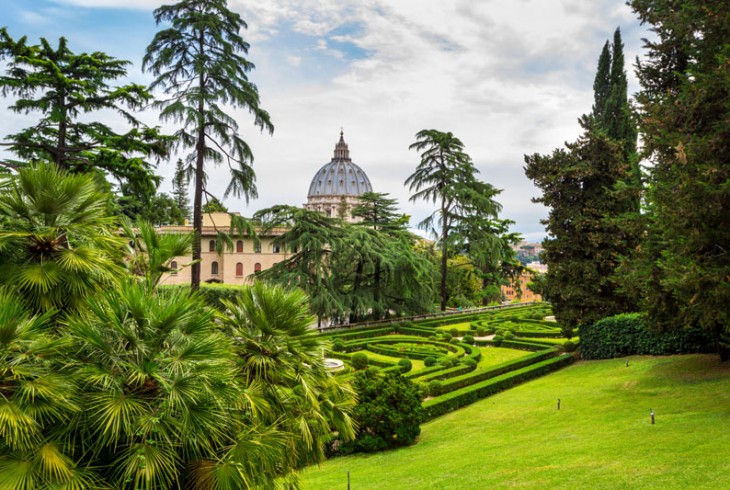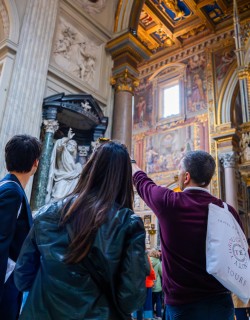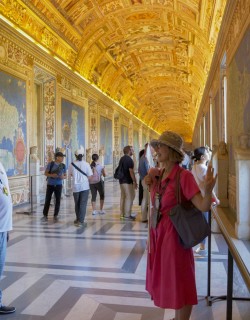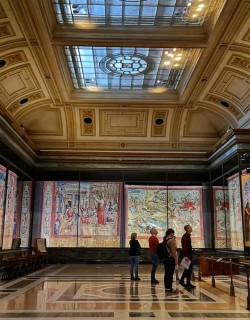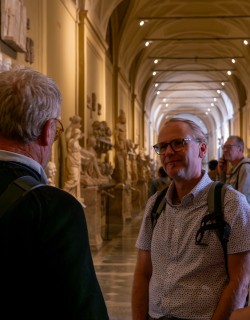You might think you know all about the Vatican City – the world's smallest country, home to the Pope, St. Peter's Basilica, the Sistine Chapel and of course the magnificent Vatican Museums. But did you know that more than two-thirds of the Vatican is given over to verdant gardens concealed behind the imposing Leonine walls, built in the 9th century to ward off Saracen marauders? An idyllic green belt in the heart of the urban bustle, the Vatican gardens tumble over the steep slopes of the Vatican hill, providing much-needed repose for generations of stressed-out Pontiffs. Whilst still exclusive, these days it's possible to walk in the footsteps of the popes and visit this peaceful oasis as part of your visit to the Vatican – read on to learn about the fascinating history of the Vatican Gardens , what to see and how to access the Pope's playground.
Table of contents:
- What are the Vatican Gardens and Why Should I Go?
- Vatican Gardens History
- Bramante's Belvedere Courtyard
- The Casino of Pius IV
- The Fountains of the Vatican Gardens
- The Animals of the Vatican Gardens
- What to See in the Gardens
- Vatican Gardens Tickets and Opening Hours
What are the Vatican Gardens and Why Should I Go?
In the summer months, when the Roman sun is at its hottest and the crowds can overwhelm even the most seasoned traveller, a visit to the peaceful Vatican gardens can be just the restorative tonic you need to get ready for the punishing itinerary that awaits in the nearby Vatican museums and Sistine Chapel. A lush haven of exotic plants and flowers, the Vatican Gardens unfold along paths and around courtyards dotted with sculptures, fountains and temples that have provided the Pope with a tranquil refuge since the Middle Ages. They include a formally landscaped Italian garden , a more picturesque English garden (complete with open lawns, woods and even a Chinese pagoda) and an elegant French garden studded with flowerbeds - visiting them is a great way to see a side of the Vatican City most tourists never get to experience.
Today the gardens are a true oasis of calm where the silence is disturbed only by birdsong, the gurgling of fountains and the occasional peal of St. Peter's nearby massive bells – the gardens boast one of the best views of the basilica's great dome in all of Rome. And in case you're in any doubt as to whose joint you're in, any lingering confusion will be quickly dispelled when you set eyes on the massive topiary Papal Coat of Arms – an immense Papal Coat of Arms sculpted entirely out of decorative shrubs and flowers set into the Vatican Garden's carefully manicured lawns in front of the Palazzo del Governatorato . Each new pope's insignia is painfully created with plants and flowers matching the colors of the crest – for the current incumbent Francis that meant planting thousands of yellow-green Euonymus Pulchellus, red begonias and brilliant bluemink flowers.
Vatican Gardens History: Europe's First Medicinal Garden
The history of the Vatican Gardens can be traced all the way back to the 13th century when, after moving the Papal residence back to the Vatican from the Lateran palace across town, Pope Nicholas III Orsini determined to carve out for himself a slice of verdant green where he could while away the hours meditating amongst shady arbors and swaying pines. But that was only half the story – the learned Nicholas was fascinated with the medicinal properties of plants, and in addition to planting orchards and meadows he conceived of a botanical garden where the healing powers of plants could be studied and cultivated.
Under his successor Nicholas IV and his private physician Simon of Genoa, the so-called Viridarium Novum quickly emerged as the first large-scale medicinal garden in Europe, where Papal doctors devised arcane remedies and tinctures and the docents of the newly founded Sapienza University came to give lectures and demonstrations amongst the rare plants of the Pope's private garden. This was one of the first ever attempts to elevate botany to the realm of science, and even today a part of the grounds is given over to rare botanicals. A wood of deciduous trees from Nicholas' first garden also still survives, the so-called boschetto .
A Luxurious Renaissance Pleasure Garden: Bramante's Belvedere Courtyard
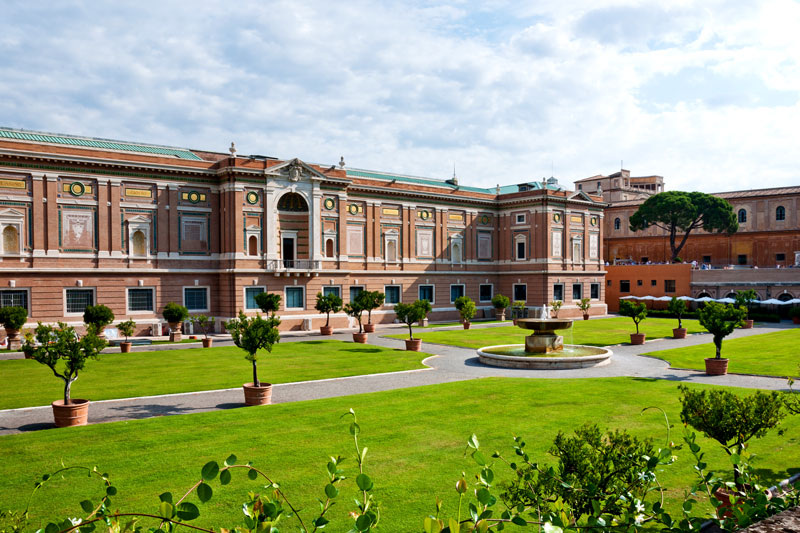
The majority of the elaborate landscaped Vatican gardens you can visit today owe their existence to the cultivated tastes of the Renaissance a few hundred years later. Over the centuries the gardens first planted by Nicholas III were expanded and refined, and by the mid-fifteenth century the gardens were studded with fountains, pools and arbours. In the 1480s Pope Innocent VIII commissioned a luxurious loggia overlooking the gardens to designs by the famous Renaissance painter Antonio del Pollaiuolo.
20 years later this was transformed into the Palazzo Belvedere and Belvedere Courtyard by Pope Julius II's star architect Donato Bramante . Inspired by ancient examples, Bramante constructed a three-level terrace of gardens and courtyards surrounded by boxwood hedges where the Pope's amazing collection of classical sculptures were displayed amidst citrus trees and laurel groves – today you can see the remains of these gardens in the Vatican Museums itinerary , centered on the Pinecone Courtyard and Octagonal Courtyard where the Laocoön and Apollo Belvedere still enjoy pride of place.
Take a look at our VATICAN IN A DAY TOUR .
The Casino of Pius IV: A Summer House Fit for a Pope
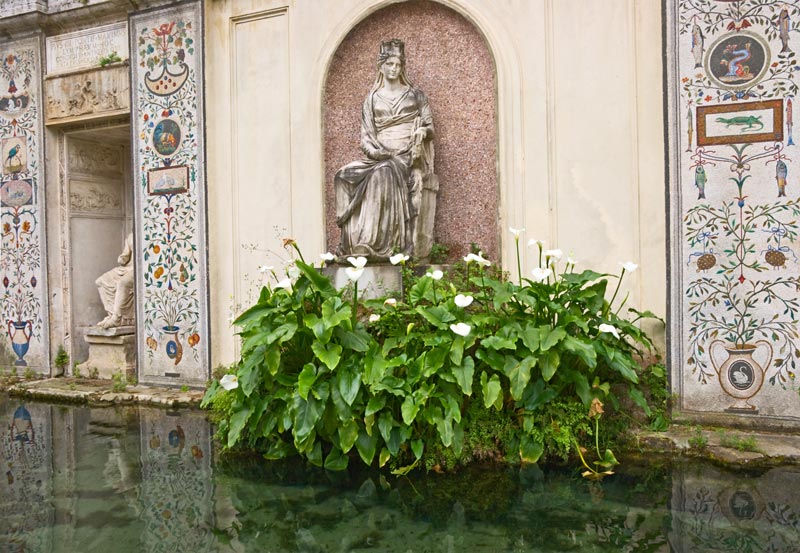
The fanatical Pope Paul IV (who you might know for his plan to destroy Michelangelo's work in the Sistine Chapel) was dissatisfied with the classical pagan sculptures that appeared at every turn in Julius' gardens, and resolved to expand them away from Bramante's courtyard. Paul died before making much progress, but under his more enlightened successor Pope Pius IV the architect Pirro Ligorio, who had made his name by designing the incredible gardens of the Villa d'Este in Tivoli, designed a magnificent summer house ( casino ) in the shady surroundings of the garden.
The spectacular building is decorated with some of the most beautiful frescoes of the 16th century , and in the summer months the Pope presided over garden parties, concerts and meetings of Rome's brightest minds outside his new casino. The self-styled Academia Notti Vaticane , or Vatican Night Academy, met to discuss the most intractable mysteries of the universe, ancient poetry and the links between faith and science immersed in the suggestive surroundings of the gardens, serenaded by the gurgling fountains of this ' new Eden.' Appropriately, the casino is now host to the Pontifical Academy of Sciences , and the formal garden in its grounds - the Giardino dei Semplici - is given over to the cultivation of medicinal plants and herbs.
The Fountains of the Vatican Gardens
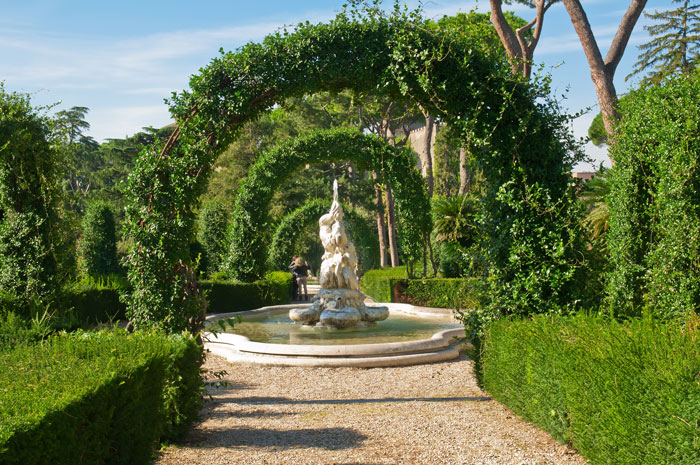
In the 1590s the gardens were adorned with cascades and large fountains, made possible when the Borghese Pope Paul V ordered the renovation of the Trajan aqueduct – the impressive fountain of the Eagle (Fontana dell'Aquilone) commemorates the arrival of the waters to the gardens , dominated by the Borghese eagle and dragon.
Of the more than 100 fountains in the garden, the most spectacular is surely the recently restored Baroque Galea fountain (Fontana della Galera) , one of the most impressive and least-known fountains in all of Rome. At the center of a massive water-filled basin is a lead sculpture of an early-modern warship, complete with masts, rigging and sails, and armed to the teeth with cannons and gun-ports. But instead of letting rip devastating rounds of cannon-fire, the guns shoot off streams of water – a war galley turned to the services of tranquility, the cardinal and poet Maffeo Barberini wrote an inscription for the fountain that describes how 'the papal war machine doesn't belch forth flames, but sweet water that quenches the fires of war.'
Jaguars and Elephants and Gazelles, Oh My: The Animals of the Vatican Gardens
As the private gardens of some of the most powerful and richest figures in history, and with the indulgent tastes to match, it's perhaps not that surprising that the Vatican Gardens have played host to plenty of exotic visitors over the centuries. Pope Boniface VIII (condemned to the 8 th circle of hell by Dante and who died in a frenzy by gnawing his own hands off according to Boccaccio) unleashed a leopard to roam the grounds in the 1200s, and in the Renaissance reign of Leo celebrity elephant Hanno spent his days here crashing through the lawns and orchards – the famous pachyderm was a gift from the king of Portugal in 1514, and was buried in the gardens near the Belvedere Courtyard.
Centuries later, the animal-loving Leo XIII had a fully fledged menagerie installed in the gardens, including gazelles and oysters donated to the Papacy by the bishop of Carthage in the 1880s. Leo's affinity with the gardens was so strong that it was in these surroundings he was immortalized in a photogram in 1896 , the first footage of a Pope ever recorded. Sadly, these days, visitors won't find exotic troupes of beasts prowling the grounds, but you will at least have the bright green parrots that have invaded the Eternal City over the last few years for company, screaming at each other across the cedar trees where they've made their nests.
What to See in the Gardens: Exotic Plants, Sacred Grottoes, a Helipad, and the Berlin Wall
It's to Leo that we owe the current layout of most of the Vatican gardens, and strolling around the Italian, French, and English gardens today, their real draw is the sheer variety of plants on show. Classic Mediterranean plants like cypresses, pines and oleanders rub shoulders with exotic flowers and shrubs from as far away as Yemen, China, the Himalayas and even Australia. You'll see a garden devoted to American cacti , and an artificial cliff where Australian monkey puzzle trees stand guard over agave plants and rare flowers. Elsewhere, there's an olive tree donated from Israel as a sign of inter-faith peace, papyrus plants from Egypt, Asian Tamarisks, and Jerusalem thorns – reputedly the spiny shrub from which Christ's crown of thorns was fashioned. The rich variety of exotic plants from all over the world donated to Popes over the centuries seek to invoke the Vatican Gardens as a modern-day Garden of Eden, where the whole word exists in harmony and abundance.
The 16th-century Italian garden boasts a labyrinth and a rose garden offering beautiful views of the distant hills of the Castelli Romani. Making your way down a shady avenue lined with holm oaks and camphor trees in the French Garden meanwhile, you'll even get a glimpse of the Vatican's helicopter pad. In another shady nook is perhaps the most surprising artefact in the gardens – a fragment of the Berlin wall from the Kreuzberg district complete with a mural by the artist Yadegar Asisi.
The religious centrepiece of the Vatican gardens is the Lourdes Grotto at the highest point on the site. The grotto is dedicated to the Virgin Mary and is a facsimile of the grotto in the small French town of Lourdes where Mary was reputed to have appeared to a young girl in 1858 – now one of the most important pilgrimage sites in the world. The Vatican's version also attracts its fair share of faithful, and every May pilgrims stage a candlelit procession through the gardens to the shrine. 15 other shrines to the Virgin dot the gardens.
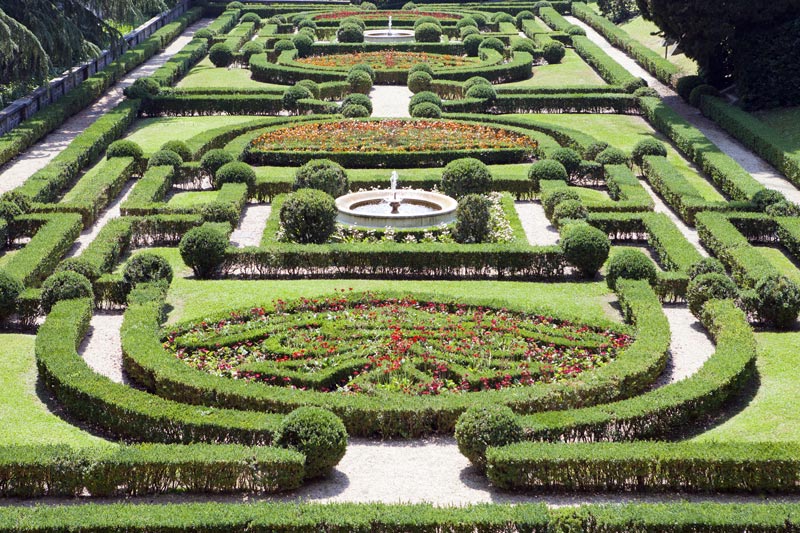
Vatican Gardens Tickets and Opening Hours
The gardens can only be visited as part of a guided tour run by the Vatican, and tickets cost €33 for adults with €22 reductions (closed on Wednesdays and Sundays). But the ticket does also include skip-the-lines entrance to the Vatican Museums and Sistine Chapel, which you can enter after finishing in the gardens. The tour lasts approximately 2 hours, and must be reserved well in advance.
Please note that whilst the Vatican Gardens itinerary is guided in each of the above options, you will not have a guide to show you around the Museums on this ticket. If you'd prefer to benefit from the company of a guide, be sure to check out Through Eternity's VATICAN GROUP TOURS.
